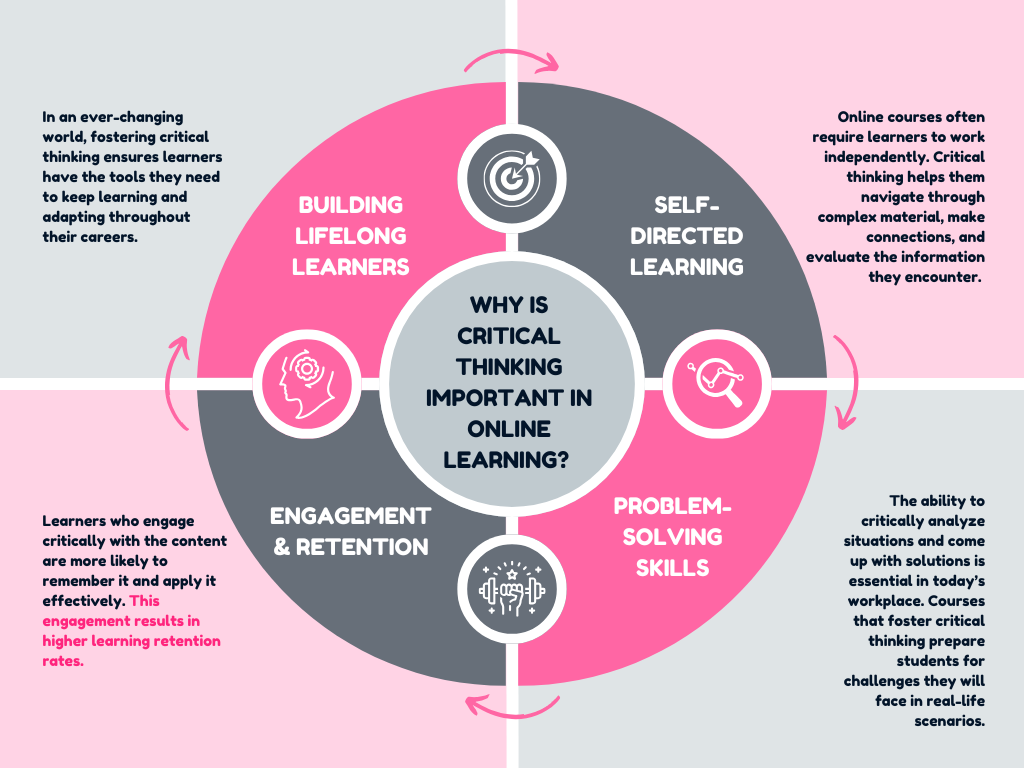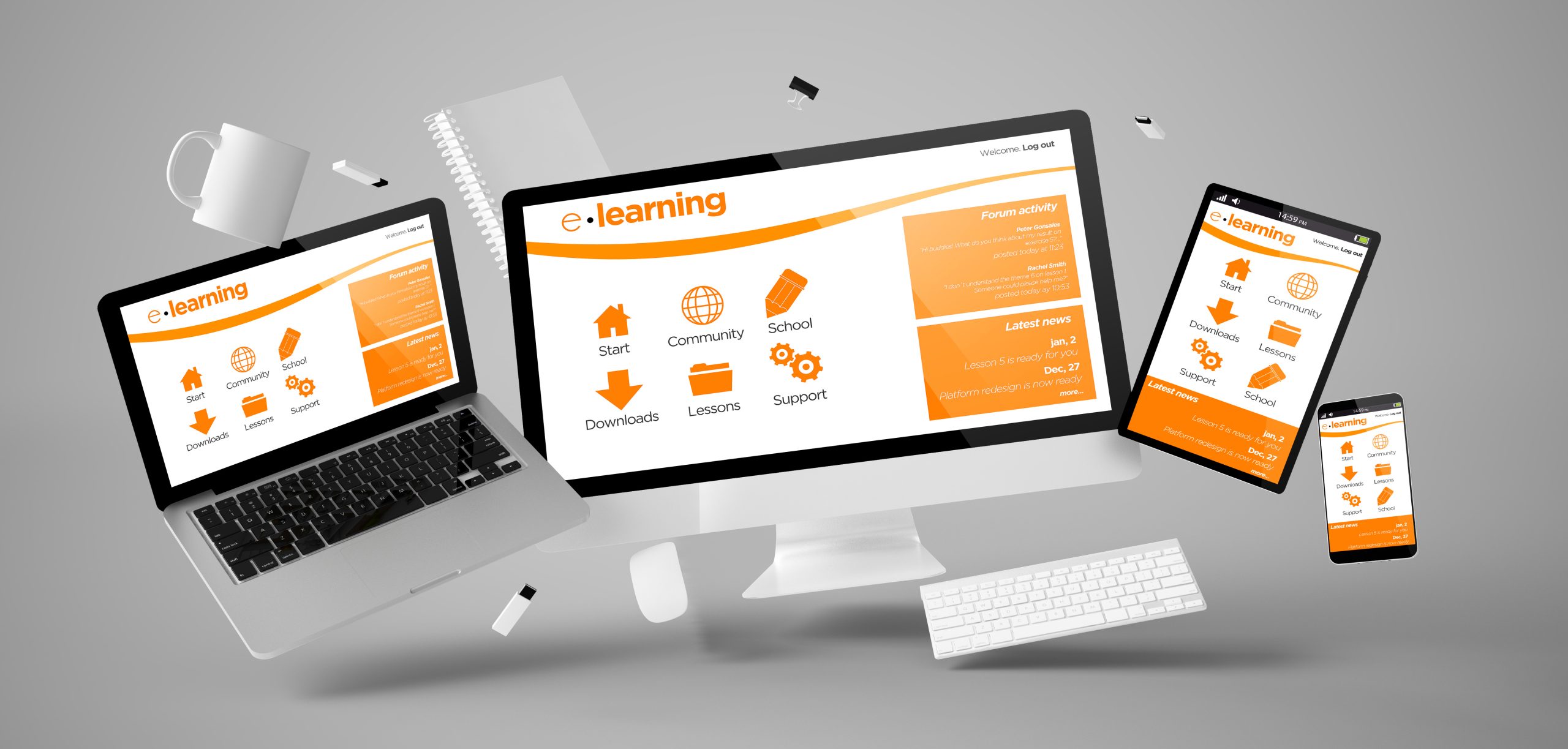As instructional designers, we understand the importance of delivering content and fostering critical thinking among learners. In today’s rapidly evolving digital learning landscape, creating online courses that promote deeper thinking, problem-solving, and applying knowledge in real-world scenarios is essential.
- But how do we design such courses?
- What strategies and best practices should we adopt to ensure our learners engage in thoughtful analysis, synthesis, and evaluation?
This blog post will explore practical methods for developing online courses that encourage critical thinking. These strategies are grounded in best practices for instructional design, cognitive psychology, and practical course-building approaches that inspire meaningful learner engagement.
Why Is Critical Thinking Important in Online Learning?
Critical thinking is analyzing, evaluating, and synthesizing information to make informed decisions. In an online learning environment, it’s even more vital because:

Best Practices for Developing Online Courses That Promote Critical Thinking
Incorporate Active Learning Strategies
Active learning is a technique that requires learners to actively participate in their learning process rather than passively consume information. It fosters critical thinking by helping students engage with content at a deeper level and develop cognitive skills like analysis, evaluation, and synthesis.
Examples of Active Learning Strategies for Online Courses:
- Case Studies: Providing real-world case studies that require learners to analyze situations, identify issues, and propose solutions encourages critical thinking. For example, a business course might present a case study about a company facing ethical challenges, prompting students to evaluate different perspectives and propose the most effective course of action.
- Problem-Based Learning (PBL): This approach challenges learners to solve complex problems collaboratively or individually. For instance, in a healthcare course, you might present a patient diagnosis problem and ask learners to gather information, propose treatments, and justify their decisions.
- Debates & Discussions: Online forums or live debates (via video conferences) are a great way to encourage learners to consider multiple viewpoints and defend their positions. For example, a political science course might ask students to debate the ethics of government surveillance, pushing them to evaluate privacy versus security concerns critically.
Use Socratic Questioning
Socratic questioning is a teaching method that encourages learners to explore deeper meanings by asking thought-provoking, open-ended questions. Using this technique, you can guide learners toward uncovering answers rather than simply presenting information.
Examples of Socratic Questions:
- Clarification: “What do you mean by that?”
- Assumptions: “What are you assuming here?”
- Evidence: “What evidence do you have to support this argument?”
- Implications: “What would happen if we followed this approach?”
- Alternative Perspectives: “Can you think of another way to approach this issue?”
Socratic questioning can be incorporated into online courses via discussion boards, quizzes, or video-based interactions. For example, in a course on ethics in business, you might ask learners, “How would you respond if you were the CEO of a company accused of unethical practices?”
Design Scenario-Based Learning
Scenario-based learning (SBL) places learners in real-life situations where they must use their judgment, reasoning, and problem-solving skills. This approach helps learners connect theory with practice and encourages them to critically evaluate outcomes before making decisions.
Examples of Scenario-Based Learning:
- Simulations: A course on project management might simulate a project environment in which learners face challenges like time constraints, budget overruns, and team conflicts. They must apply critical thinking to navigate these challenges and determine the best action.
- Role-Playing: In a conflict resolution training course, learners might assume roles such as a manager and an employee to work through a conflict scenario. They must use critical thinking to choose their actions and reflect on the outcomes.
Scenario-based learning encourages learners to apply their knowledge to practical, real-world situations, reinforcing critical thinking through decision-making processes.
Foster Collaborative Learning Opportunities
Collaboration fosters critical thinking because it requires learners to interact with others, exchange ideas, and evaluate alternative perspectives. Group work encourages learners to consider different viewpoints and critically analyze concepts and solutions.
Examples of Collaborative Learning Strategies:
- Discussion Boards: Create thought-provoking questions that encourage learners to interact with each other and share insights. For example, an environmental science course might have students discuss the impacts of climate change on different ecosystems, comparing and contrasting opinions.
- Group Projects: Assign group projects that require learners to research, debate, and make collective decisions. For instance, in a marketing course, groups could collaborate to create a marketing plan for a product, encouraging critical analysis of the target market, product positioning, and strategy.
- Peer Reviews Allow learners to assess each other’s work. They not only give learners feedback but also encourage them to critically analyze the work of others, improving their judgment and analytical skills.
Include Open-Ended Assessments
Traditional multiple-choice tests often fail to assess critical thinking because they focus on recall rather than deep understanding. Open-ended assessments, such as essays, case studies, or project-based tasks, encourage learners to synthesize information, make judgments, and defend their positions.
Examples of Open-Ended Assessments:
- Essays & Research Papers: In a history course, you could ask learners to write an essay evaluating a historical event’s long-term effects. This requires them to synthesize various sources of information and present a well-supported argument.
- Project-Based Assessments: In an entrepreneurship course, students might be asked to develop a business plan for a startup, integrating knowledge from various areas such as marketing, finance, and operations.
- Reflection Journals: Encourage learners to reflect on their learning process, what they’ve found challenging, and how they’ve applied their critical thinking to solve problems.
Encourage Metacognition
Metacognition is the process of thinking about one’s thinking. Teaching learners to reflect on their thought processes can improve their ability to think critically. In an online course, you can foster metacognition by encouraging learners to:
- Self-Assessment: Regularly ask learners to reflect on what they’ve learned, their strategies, and how they can improve.
- Think-Aloud Protocols: Ask learners to express their thought processes verbally while solving a problem or completing an assignment. This helps the learner analyze their approach and allows instructors to gauge their critical thinking skills.
Use Technology to Enhance Critical Thinking
Technology can enhance the development of critical thinking by offering interactive and engaging tools that push learners to explore, question, and evaluate information. Here are some ways technology can support critical thinking in online courses:
- Interactive Videos: Incorporate clickable video content where learners can explore different outcomes based on their decisions. For example, in a leadership training course, learners could watch a scenario where a manager faces a tough decision and then choose different paths to see how the situation unfolds.
- Gamification: Add game-like elements, such as points, levels, or achievements, to assessments or learning modules. This can increase engagement and prompt learners to think critically to achieve their learning goals.
- AI-Based Adaptive Learning: Use AI technology to create adaptive learning paths that adjust based on the learner’s performance. This ensures learners are continually challenged and encouraged to think critically at their own pace.
Developing online courses that foster critical thinking requires a combination of interactive learning strategies, engagement techniques, and meaningful assessments. By incorporating best practices like active learning, scenario-based design, Socratic questioning, collaborative activities, and open-ended assessments, instructional designers can create courses that encourage learners to think deeply, make decisions, and solve complex problems.
Critical thinking is essential for developing lifelong learners who can adapt to new situations and challenges in their professional and personal lives. Following these best practices can empower learners to think critically and apply their knowledge innovatively.




